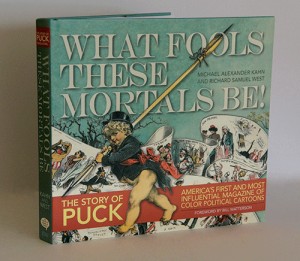During Michael Kahn’s quarter in Washington, D.C., as a UCLA undergraduate during the 1960s, he stumbled upon a framed cartoon of a tattooed man in the home of one of his professors.
Kahn inquired about what it meant, and his professor told him that the cartoon had elected the 22nd president of the United States.
The answer sparked Kahn’s passion for collecting political cartoons, which has lasted more than 40 years and has led to the publication of a new book by the UCLA alumnus titled “Puck: What Fools These Mortals Be.”
The book is a history of Puck Magazine, a political satire publication known for its detailed editorial cartoons that were major factors in shaping public opinion during the late 19th and early 20th centuries.
The magazine, published in New York City between 1876 and 1918, was known for its large, colorful cartoons that would often push an agenda of reform and progressive politics.
“As opposed to the newspapers of the time, the magazine was gloriously interesting,” Kahn said. “The cartoons are so cool, so colorful and so easy to understand.”
Along with the book, Kahn, who works as an attorney in San Francisco, will teach a Fiat Lux seminar in winter quarter that will take students through a series of presidential elections using political cartoons from Puck, as well as its main rival Judge, as a guide.
Jenny Robb, curator of the Ohio State University’s Billy Ireland Cartoon Library and Museum, said it was Puck’s color centerpieces that distinguished it from other magazines of the time.
“Puck really pioneered the process for creating large and quite beautiful color lithographic prints for political cartoons,” Robb said.
The image that Kahn saw hanging on the wall in Washington, D.C., was the “The Tattooed Man,” the first in a series of cartoons criticizing 1884 Republican presidential candidate James Blaine for his numerous financial scandals.

During the 1884 election, Blaine’s opponent, Democrat Grover Cleveland, was elected president, ending 16 years of Republican rule in the White House.
Both Blaine and Cleveland credited Puck Magazine with the results of the election, Kahn said.
Richard West, Kahn’s co-author, said it was the visual nature of the Puck cartoons that made it effective political messaging to the average person.
“You can write the hardest-hitting editorial ever but it doesn’t catch anyone’s eye,” West said. “If you do a political cartoon of a candidate and show him as an ass, then that’s an image that sticks.”
Ever since seeing the cartoon on his professor’s wall, Kahn said he has been enthusiastic about collecting Puck Magazine cartoons.
West’s career as a dealer in periodicals put him in contact with Kahn as he searched for cartoons to add to his personal collection. West credits Kahn with being the spark behind the idea for the book.
“(Kahn) is a force of nature – when he wants to do something, it gets done,” West said.
Even though some of the images were printed more than a century ago, Kahn said he thinks common threads about wealth inequality, immigration and the influence of money in politics still strike a nerve today.
“If you look at the cartoon and say, ‘Oh my god, nothing’s changed,’ you’d be right,” Kahn said. “You could print many of the same cartoons today if you changed the names.”
Kahn said the lack of media outlets during the magazine’s heyday meant that its colorful and iconic images were often the main source of political news and made a major difference in the lives of many Americans.
“Puck was all television, Internet and radio rolled into one,” Kahn said. “Puck was able to change perception, which more often than not, was able to change votes.”
